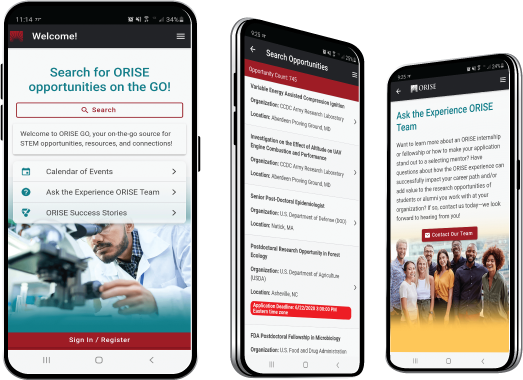EPA Effects of PFAS Chemicals in Amphibians Fellowship
-
An application
-
Transcript(s) – For this opportunity, an unofficial transcript or copy of the student academic records printed by the applicant or by academic advisors from internal institution systems may be submitted. All transcripts must be in English or include an official English translation. Click here for detailed information about acceptable transcripts.
-
A current resume/CV, including academic history, employment history, relevant experiences, and publication list
-
Two educational or professional recommendations. Click here for detailed information about recommendations.
*Applications may be reviewed on a rolling-basis and this posting could close before the deadline. Click here for information about the selection process.
EPA Office/Lab and Location: A research opportunity is available at the Environmental Protection Agency (EPA), Office of Research and Development (ORD), Center for Computational Toxicology and Exposure (CCTE), Great Lakes Toxicology & Ecology Division (GLTED) located in Duluth, Minnesota.
Research Project: PFAS chemicals have been identified as contaminants of emerging concern and currently lack toxicological data necessary for decision making. EPA is mandated to address the endocrine disrupting potential of chemicals and a growing body of evidence suggests that some PFAS chemicals can disrupt thyroid function. For the majority of PFAS chemicals there is a lack of information regarding whether they have the potential to cause adverse effects from impacts on thyroid hormone status. Understanding the important molecular targets within the network of processes involved in maintaining normal functioning thyroid hormone levels, and what approaches to best assess activity at those targets are critical to developing a comprehensive approach to evaluating thyroid hormone disrupting potential of large numbers of chemicals.
This research aims to utilize a recently developed battery of in vitro high-throughput screening (HTS) assays to interrogate chemical activity toward various biochemical mechanisms critical to thyroid function. This will include six thyroid-related HTS assays to screen a PFAS chemical library and determine the potential for PFAS chemicals to inhibit these thyroid-related targets. Further, this research aims to utilize these in vitro PFAS activity data, together with an in vitro-to-in vivo translational framework to predict which PFAS compounds have the highest likelihood of causing thyroid disruption in aquatic vertebrates. Coordinated efforts will be undertaken in the mammalian model in parallel to these efforts to bolster cross-species concordance of PFAS modes of action and adverse outcome pathways (AOPs) related to thyroid disruption.
- Applying innovative and cutting-edge approaches in in vitro-to-in vivo extrapolation and reverse toxicokinetics to translate effect concentrations measured in multi-well plates to equivalent blood, tissue, or environmental media concentrations.
- Developing high-throughput techniques for collection, batch processing, and analysis of biofluid and tissue samples suitable for molecular, biochemical, and/or histological analyses.
- Developing and implementing a data archiving and storage system.
- Identifying statistical and performance-based measures of assay and data quality and implementing quality assurance and quality control.
- Using analytical chemistry methods to verify chemical concentrations, purity, and availability/partitioning in the test vessels.
- Generating samples for transcriptomic and metabolomic analyses and applying statistical and bioinformatic tools to analyze DNA microarray and/or DNA/RNA sequencing results.
- Compiling and synthesizing data from the peer-reviewed literature and on-line data sources and organizing it according to the AOP framework
- Analyzing gene expression using real-time polymerase chain reaction and developing novel primers, probes, and standards for gene expression analyses.
- Analyzing steroid hormones and plasma proteins using radioimmunoassay (RIAs) and enzyme-linked immunosorbent assays (ELISAs)
- Presenting research results at regional, national, and/or international conferences and workshops.
- Contributing to the preparation of peer-reviewed journal articles and disseminating research results to project partners and stakeholders.
- Conducting field-based research outdoors and/or at remote laboratory locations other than the primary training location
Learning Objectives: The participant will be integrated into a transdisciplinary research team and engaged in multiple aspects of project planning, communication and coordination, research implementation, and analysis. The participant will be afforded an opportunity to interact with internationally recognized leaders, both within and outside EPA. The participant may contribute to and/or publish original research. The participant will gain knowledge, skills, and abilities needed to apply new technologies and associated data to regulatory decision-making at the local, national, and/or international scale and to pursue a professional career in life sciences research.The participant will learn a diversity of laboratory, analytical, and computational techniques which can be applied across life sciences research fields. The participant will learn to operate and use a range of scientific equipment. The participant will learn to evaluate data quality, troubleshoot research results, apply statistical methods for data analysis and interpretation.
Mentor(s): The mentor for this opportunity is Sigmund Degitz (degitz.sigmund@epa.gov). If you have questions about the nature of the research please contact the mentor(s).
Anticipated Appointment Start Date: Winter 2020/2021. All start dates are flexible and vary depending on numerous factors. Click here for detailed information about start dates.
Appointment Length: The appointment will initially be for one year and may be renewed up to three or four additional years upon EPA recommendation and subject to availability of funding.
Level of Participation: The appointment is full-time.
Participant Stipend: The participant will receive a monthly stipend commensurate with educational level and experience. Click here for detailed information about full-time stipends.
EPA Security Clearance: Completion of a successful background investigation by the Office of Personnel Management (OPM) is required for an applicant to be on-boarded at EPA.
ORISE Information: This program, administered by ORAU through its contract with the U.S. Department of Energy (DOE) to manage the Oak Ridge Institute for Science and Education (ORISE), was established through an interagency agreement between DOE and EPA. Participants do not become employees of EPA, DOE or the program administrator, and there are no employment-related benefits. Proof of health insurance is required for participation in this program. Health insurance can be obtained through ORISE.
Questions: Please see the FAQ section of our website. After reading, if you have additional questions about the application process please email EPArpp@orau.org and include the reference code for this opportunity.
The qualified candidate should have received a doctoral degree in one of the relevant fields, or be currently pursuing the degrees and will reach completion by the start of the appointment. Degree must have been received within five years of the appointment start date.
- Previous research experience, beyond lab-oriented course work alone.
- Previous experience writing peer reviewed journal articles.
- Previous experience with science communication to a diversity of technical and non-technical audiences.
- Computational skills (e.g., programming, R-based statistics)
- Previous experience working with omics data and/or high throughput data sets such as those from EPA's ToxCast program.
- Experience conducting bioassays at the in vitro, in vivo, or field scale.
- Previous experience working with aquatic organisms such as fish and amphibians.
- Experience with basic molecular biology techniques used for analysis of proteins and nucleic acids (e.g., gel electrophoresis, PCR, quantitative real-time PCR, use of thermocyclers and/or bioanalyzers, etc.)
- Course work in biostatistics and/or bioinformatics
- Cell culture experience (e.g., plating, maintaining, freezing animal cells using aseptic technique).
- Experience with analytical chemistry instrumentation and extraction methods
- Citizenship: U.S. Citizen Only
- Degree: Doctoral Degree received within the last 60 months or anticipated to be received by 12/21/2020 11:59:00 PM.
- Discipline(s):
- Veteran Status: Veterans Preference, degree received within the last 120 month(s).

 ORISE GO
ORISE GO

The ORISE GO mobile app helps you stay engaged, connected and informed during your ORISE experience – from application, to offer, through your appointment and even as an ORISE alum!





